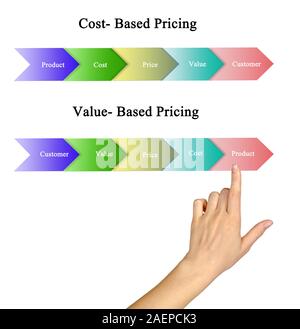
Mindful Pricing: Transforming Organizations Through Value Based Pricing.
#Cost based pricing vs value based pricing plus#
If by any case the prices are lower, the customer perceives the value of that product lower than the cost incurred plus the profit margin. Prices set on value-based pricing are always higher or equal to the prices set from cost-plus pricing. In order to maximize the profitability of the products and services, the business needs to quantify the benefits the products offer to their customers and also review customers buying decision principles and maximize on that. At the same time, the price that the competitors charge should also be considered. This is because prices are controlled by the value of the benefits the business offers to its customer. A product with unique benefit gets an advantage over competitor products, and therefore can be sold on value-based pricing. The company selling on value-based pricing should come up with a more innovative way and exciting way of using that item which the other competitor doesnt offer. For example, two companies could be selling the same type of an item, one on cost-plus pricing while the other on value-based pricing technique. There must be some benefits and values attached to the item for the customer to pay for a higher price willingly. Manufacturers gather feedback from the clients on experience and features, use this information to come up with a more innovative brand which increases the value and benefit as perceived by the customer. Markets dealing with luxurious items like vehicles mostly use the value-based pricing approach. In this case, the value becomes the most important aspect and a driving force in every business as it affects the price and willingness to pay. This is what affects the price a consumer is willing to pay. When we talk about the perceived value of an item, it simply means the value of an item a consumer has in his/her mind.


In case, the value of a brand tends to fall due to some reasons, the firms pricing policy needs to be reset to a cost-based pricing model. A famous celebrity, who wears a designers outfit to a big event, can increase the perceived value of the brand indeed. For instance, famous fashion designers charge heavy prices from customers based on their conception of how they associate the brand with their identity or status. The fashion industry, undoubtedly, highly follows the value-based pricing approach for determining price. (Note: The concept of value-based pricing establishes prices on the basis of perceived value for a product or service, the cost-plus pricing approach considers production costs while calculating the ultimate price). This helps sellers in assessing the price of vehicle. For instance, luxury car manufacturers ask for customer feedback that measures the perceived value of customers experiences while driving a specific vehicle.

Marketers follow several techniques for assigning value to a product. The perceived value is the value or worth of a product that customers are agreeing to assign, and as a result, it has a direct effect on the product price that the customers pay for buying it. Besides, the companies design products that directly increase the self-esteem of their customers. The principle of value-based pricing goes well with companies that create amazing products and services in order to deliver exceptional experiences to their customers. Back to: MARKETING, SALES, ADVERTISING, & PR How does Value-based Pricing Work?


 0 kommentar(er)
0 kommentar(er)
